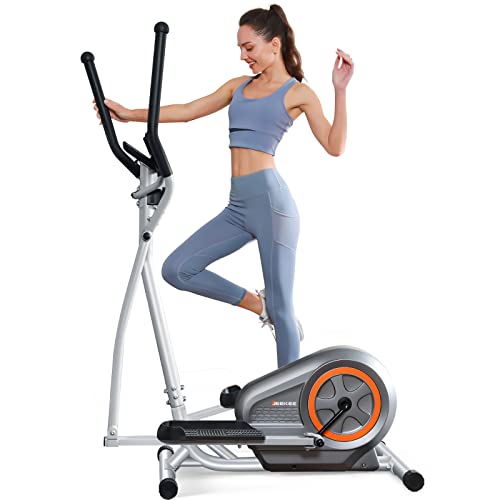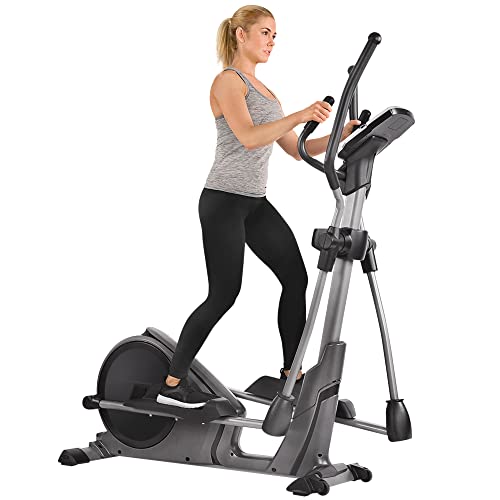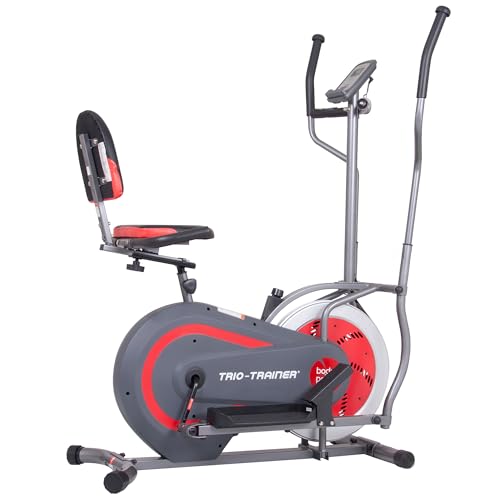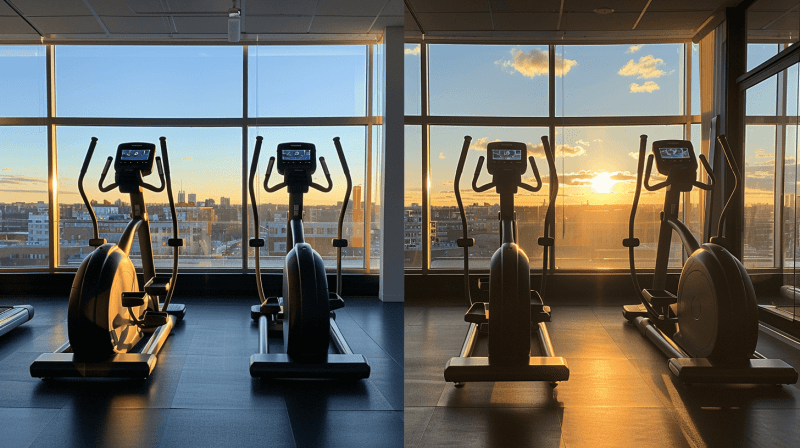When you're just starting out with an elliptical machine, you might feel tempted to push yourself too hard or worry that you're not doing enough. The truth is, finding the right duration for your workouts isn't about matching what others do - it's about understanding your own fitness level and goals. While some beginners can handle longer sessions right away, others need to start with shorter intervals to build their endurance safely. Whether you're aiming to lose weight, improve cardiovascular health, or simply stay active, knowing the ideal workout length can make the difference between success and burnout.
Key Takeaways
-
Start with 10-15 minute sessions to allow your body to adapt to the new exercise while maintaining moderate intensity.
-
Increase workout duration gradually by 2-3 minutes per session until reaching a target of 30-45 minutes.
-
Begin with 3-4 sessions per week, allowing proper rest between workouts to prevent overexertion and injury.
-
Focus on maintaining proper form during shorter sessions before increasing duration or resistance levels.
-
Monitor heart rate to stay between 60-75% of maximum while gradually building endurance through consistent workouts.
Understanding Elliptical Training Basics
Getting started with an elliptical machine doesn't have to be complicated. As a beginner, you'll want to focus on developing proper form and building your cardiovascular endurance through consistent, low-impact workout sessions. Your initial goal should be to maintain a steady pace that allows you to exercise comfortably while gradually increasing your duration.
When you first step onto the elliptical machine, start with a resistance level that lets you maintain proper posture and technique. You'll want to keep your back straight, use your entire foot on the pedals, and maintain a controlled movement pattern. Begin with 10-minute sessions, which you can extend by 2-3 minutes each time you work out, working toward a target of 30-45 minutes of continuous exercise.
Remember that your heart rate and intensity level should remain manageable during these early sessions. Don't rush to increase the resistance or incline settings until you've mastered the basics and can complete longer durations without stopping. This measured approach helps you build a strong foundation while reducing the risk of injury and ensuring long-term success with your elliptical training program. The natural locomotive stride pattern of the elliptical makes it an excellent alternative to walking or running while minimizing impact on your joints.
Recommended Duration for Beginners
When first stepping onto an elliptical machine, your initial workouts should last between 10-15 minutes. As a beginner, you'll want to focus on maintaining a moderate intensity while your body adjusts to this new form of cardiovascular exercise, paying close attention to your heart rate and overall comfort level.
Over the next several days and weeks, you'll want to gradually increase the time spent on the elliptical by adding 2-3 minutes to each session. This steady progression helps build your endurance without overwhelming your body or risking injury. Your goal should be working up to 30-45 minutes of continuous movement on the machine without stopping.
Once you're able to complete 30-45 minute sessions comfortably, you can begin exploring additional challenges in your beginner elliptical workout routine. At this point, you're ready to start adjusting resistance levels and incline settings to further enhance your fitness journey. Remember to maintain proper form throughout your sessions, and always listen to your body's signals as you increase both duration and intensity of your workouts. Consider incorporating tempo-based music workouts to maintain a consistent rhythm and make your sessions more enjoyable.
Setting the Right Intensity Level
Finding the right intensity level on an elliptical machine starts with understanding your current fitness capabilities. You'll want to maintain a heart rate between 60-75% of your maximum heart rate to achieve optimal cardiovascular health benefits while using this exercise equipment.
When starting your elliptical machine workout, begin with a lower resistance level and gradually increase it as your fitness level improves. The combination of incline and resistance settings allows you to customize your workout intensity while targeting different muscle groups effectively.
- Monitor your perceived exertion during exercise, adjusting the intensity if you're feeling overly strained or finding it too easy
- Start with 5-10 minutes at a moderate pace to warm up, then increase resistance gradually until you reach your target heart rate
- Use the machine's built-in heart rate monitors or wear a fitness tracker to guarantee you're staying within the recommended range
Remember that proper intensity management helps prevent overexertion while maximizing workout benefits. As you become more comfortable with the elliptical machine, you can progressively increase both duration and resistance to continue challenging your cardiovascular system and improving your overall fitness. The low-impact design makes it an ideal choice for those concerned about joint strain while maintaining an intensive workout routine.
Proper Form and Technique
Now that you've established the right intensity level, mastering proper form on the elliptical machine will help prevent injury and maximize your workout results. Start at a lower intensity with minimal resistance and a gentle incline, allowing yourself to focus on maintaining proper positioning and movement patterns. Make sure to keep your feet pointed forward and your knees slightly bent throughout the exercise.
Your posture is essential when using this fitness equipment. Keep your body upright and maintain a straight back, resisting the urge to lean or drape over the handles. While it's natural to want to monitor your heart rate, don't compromise your form by hunching over to check the heart rate monitor. Instead, maintain proper alignment and adjust your positioning as needed.
As your coordination improves and you become more comfortable with the motion, you can gradually increase the resistance and incline to target different muscle groups more effectively. Remember that proper form should always take precedence over intensity - if you notice your technique suffering, reduce the machine's settings until you can maintain correct positioning throughout your workout. Consider incorporating pedaling backward to engage your muscles differently and add variety to your routine.
Building Endurance Gradually
For long-term success on the elliptical, building endurance requires a systematic and patient approach. Start by using the machine for 10-15 minutes per session, keeping your heart rate within the moderate intensity zone of 60-75% of your maximum heart rate. As you become more comfortable with the basic movements, you'll be ready to increase your duration gradually.
To develop your cardiovascular fitness effectively, follow these key progression steps:
- Add 2-3 minutes to your elliptical sessions each week, maintaining proper form throughout the extended duration
- Focus on achieving consistent, steady movements before adjusting resistance or incline settings
- Work toward the goal of 30-45 minutes of continuous exercise without stopping
Remember that building endurance isn't about pushing yourself too hard too soon. Instead, concentrate on establishing a regular routine while maintaining proper technique during your workouts. By gradually increasing your time on the machine, you'll develop the stamina needed for longer sessions while minimizing the risk of injury or burnout. This measured approach helps enable sustainable progress in your fitness journey. Aim to maintain a rate of perceived exertion between 4-6 on a scale of 1-10 to ensure you're working at an appropriate intensity level for a beginner.
Common Beginner Mistakes
While building endurance is important, many newcomers make avoidable mistakes that can hinder their progress on the elliptical machine. To improve your cardiovascular health safely, you'll need to recognize and avoid these common pitfalls that can lead to frustration or injury.
One of the biggest mistakes is overdoing your workouts when you first use the elliptical trainer. Instead of pushing beyond the recommended 30-45 minutes per session, start with shorter durations 3-4 times per week, allowing your body to rest between workouts. As you become more comfortable, you can gradually increase your time and frequency.
Another critical error is increasing the resistance or incline too quickly. Your body needs time to adapt to the movement pattern, so start with lower settings and progress slowly. Additionally, maintain proper form by keeping your posture upright and avoiding a death grip on the handles to avoid injury.
Don't fall into the trap of focusing solely on the calorie display. Instead, pay attention to how your body feels during exercise, and adjust your intensity based on your perceived exertion level. This approach will help you develop a more sustainable workout routine.
Incorporating a proper warm-up routine with light stretching helps prepare your muscles and reduces the risk of exercise-related injuries.
Heart Rate Monitoring Guidelines
Successful elliptical training depends heavily on maintaining the right heart rate zones during your workouts. For ideal results during aerobic exercise, you'll want to keep your heart rate between 60-75% of your maximum heart rate, which is good for your heart and helps reduce the risk of overexertion. Using a heart rate monitor during your elliptical workouts guarantees you're getting an effective cardio workout while maintaining proper blood flow.
To make the most of your heart rate monitoring:
- Calculate your target heart rate zone by consulting with a healthcare provider, who'll determine your specific maximum heart rate based on factors like age and fitness level
- Start with shorter sessions at a moderate pace, gradually increasing the intensity as your cardiovascular fitness improves
- Monitor your heart rate throughout your workout, adjusting speed and resistance to stay within your target zone
As you become more comfortable with the equipment, you can begin to challenge yourself by adding intervals of higher intensity while still maintaining awareness of your heart rate. Remember to adjust your workout intensity if you notice your heart rate climbing too high or staying too low for extended periods.
Effective Workout Structure
Creating an effective workout structure on the elliptical machine starts with understanding your fitness level and goals. If you're looking to lose weight or maintain a healthy lifestyle, you'll want to begin with shorter sessions of 10-15 minutes and gradually build up your endurance.
To develop a good foundation, focus on maintaining proper form with the push and pull motion while keeping your posture upright. You can structure your workouts in two primary ways: steady-state training or interval training. For steady-state sessions, maintain a consistent moderate pace that allows you to complete your planned duration without stopping.
As you become more comfortable with the elliptical cross trainer, try incorporating HIIT workout segments into your routine. You can alternate between periods of higher intensity and recovery phases to help boost your cardiovascular fitness. Start by increasing your session length by 2-3 minutes each week until you can sustain 30-45 minutes of continuous movement. Remember to adjust the resistance and incline gradually as your strength and coordination improve, which will help prevent plateau and maintain progress in your fitness journey.
Recovery and Rest Periods
Along with proper workout technique, rest and recovery periods play a critical role in your elliptical training success. As a beginner trying to help you lose weight and burn calories, it's crucial to give your upper body and lower body sufficient time to recover between sessions, which typically means taking at least one full day off between workouts.
For the best results while staying Beneficial for losing weight, follow these recovery guidelines:
-
Start with two to three elliptical sessions per week, spacing them out across five days to guarantee proper recovery time between workouts
-
On rest days, engage in low intensity activities like gentle walking or stretching to promote active recovery without overtaxing your muscles
-
Listen to your body's signals and adjust your workout schedule if you experience persistent fatigue or muscle soreness
Remember that proper recovery is just as important as the workout itself. Your muscles need time to repair and adapt to the new demands you're placing on them, so don't rush the process. By balancing exercise with adequate rest periods, you'll build a sustainable fitness routine that promotes long-term success.
Progressive Training Methods
Once you've established a consistent rest and recovery routine, it's time to focus on building your endurance and strength systematically. Using an elliptical requires a methodical approach to progression, starting with just 10 minutes of activity and gradually increasing your time by two to three minutes during subsequent sessions.
Your initial sessions should focus on mastering proper form before increasing intensity, with one foot placed firmly on each pedal and your body maintaining an upright position. Using the elliptical at low resistance and minimal incline will help you develop proper coordination while holding onto the handles for stability.
Interval training becomes a great tool once you can maintain 30-45 minutes of continuous movement. You'll want to challenge yourself in three times ways: adjusting resistance levels, increasing the ramp angle, and extending your workout duration. These progressive adjustments will help maximize the number of calories burned while building your cardiovascular fitness. Remember to maintain proper posture throughout your workouts, keeping your knees slightly bent and your feet pointing forward to prevent strain or injury during your training sessions.
Frequently Asked Questions
How Long on Elliptical for Beginners?
Start with 10-15 minutes while maintaining proper elliptical form. You'll want to track your progress as you gradually increase by 2-3 minutes each session until you're comfortably doing 30-45 minutes of enjoyable exercise.
Is 30 Minutes of Elliptical a Day Enough?
Yes, 30 minutes of daily elliptical training is enough to start seeing benefits. You'll maximize results by using proper settings, monitoring your intensity, and gradually increasing your duration as your fitness improves.
Is an Elliptical Good for Beginners?
Like a gentle wave, the elliptical's perfect for beginners! You'll enjoy low-impact benefits, easy-to-learn techniques, and adjustable resistance levels. Start with proper posture and monitor your heart rate for a safe, effective workout.
How Long Should I Use the Elliptical to Lose Weight?
For ideal weight loss, you'll want to use the elliptical for 45-60 minutes, 4-5 times weekly. Start with proper form, gradually increase resistance, and incorporate intervals while monitoring your heart rate to maximize calorie burn.
Conclusion
Successful, sensible starts on the elliptical machine will lead to lasting fitness gains. You'll find that following these fundamental guidelines - beginning with brief 10-15 minute sessions, progressing patiently, and practicing proper posture - creates a solid foundation for your fitness journey. By monitoring your movements mindfully and gradually building endurance, you're setting yourself up for sustainable success. Remember to respect your body's rhythm and rest requirements while steadily advancing your workout duration.







